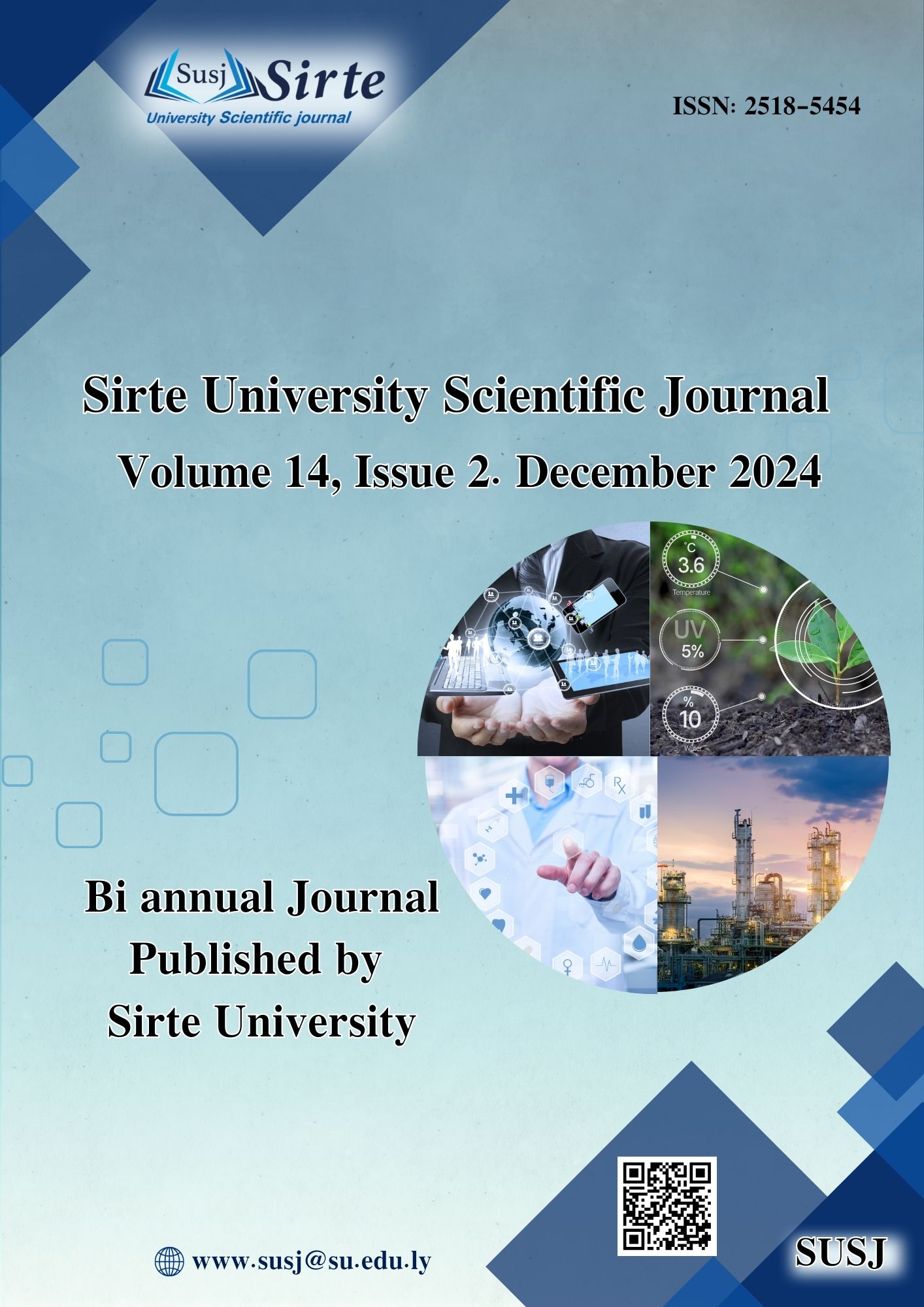Investigations of genitourinary candida infections of patients women attending gynecology clinic at sirte clinics complex, Sirte city, Libya
DOI:
https://doi.org/10.37375/susj.v14i2.3103Keywords:
Candida Infections, Genitourinary Fungal Infection, patients women.Abstract
Candidiasis is an opportunistic fungal infection that occurs due to yeasts of the genus Candida, which infects target immobilized individuals with a diminished immune system. It causes infections in the urinary and reproductive systems and is known to be responsible for genital and urinary infections worldwide. Candida albicans and Candida glabrata are most often responsible for the disease, and both can lead to vaginal candidiasis, including during pregnancy. Candida urinary tract infection has been on the rise in recent times, particularly among the hospitalised patients. Often, those people who undergo catheterization suffer from candiduria. In case the vaginal candidiasis is left untreated, then severe complications such as placental inflammation, pelvic inflammatory diseases, and even miscarriage may occur. Aim of study: This study aims to estimate the incidence of genitourinary fungal candidiasis among patients women attending Gynecology clinic at sirte Clinics Complex and identify potential risk factors associated with this condition. Materials and Methods: Sirte, Libya was the local setting of the study which was carried out between May and July 2023.Midstream urine sample was obtained from 100 patients women attending the gynecological clinic. Socio-demographic and clinical information was gathered by means of specially developed questionnaires in a standardised form. Laboratory investigations to diagnose fungal infections in urine involve the use of centrifuges to separate and deposit samples and their components. Sediment is then collected and examined under a microscope to identify fungal cells as well as using gram stain techniques. Specifically, SPSS analytic software was used, and chi-square tests where appropriate. Results: Among 100 samples, 91% tested positive for candida infection, with the highest rates in women aged ≤24 (42.85%) and 25–34 (28.57%). Diabetes showed a significant correlation with candidiasis (83.51%, p = 0.03), and unmarried women had higher infection rates (76.92%). All infected married women had no history of abortion, but multiple pregnancies were significantly associated (p = 0.0001). Metronidazole use reduced infection rates (p < 0.0001), and common symptoms included vaginal discharge (55.55%) and pain with urination (44.44%).
Conclusion: This study found a high prevalence of urinary fungal infections among women in sirte during (May–June 2023), with a significant decrease in infection rates with increasing age. The infections were most common in diabetic and unmarried women, while married women with multiple pregnancies had the highest rates. These findings highlight the need for regular screenings and preventive measures. Recommendation: Taking into account the study results, it is suggested that structured screening programs for urinary fungal infections in women should be implemented , with special focus on high-risk groups, such as diabetic and pregnant women. Furthermore, public education should directed to proper hygiene, correct medication use and early medical consultation in efforts of decreasing such infections prevalence.
References
Al-Oebady, A. A. (2015):"The prevalence of Candida species in urine samples of patients with urinary tract infections." Journal of Medical Microbiology, 64(5), 613-619.
Anaissie EJ, Anstead GM, Arias CA, Arora A, Baer SL, Bazan III C, Bradsher Jr RW, Chintapalli KN, Deresinski SC, Diekema DJ, Dignani MC. (2010): Clinical Mycology 2nd Ed [PDF] [tahir99] VRG. pdf.
Arocha, M., et al. (2019):"Fungal infections in patients with diabetes mellitus: a systematic review and meta-analysis." Mycoses, 62(11), 992-1000.
Behzadi, Payam, Elham Behzadi, and Reza Ranjbar, (2022):urinary tract infection and candida Albicans. Central European Journal of Urology 68(1): 96. /pmc/articles /PMC4408390/ (February 19, 2022).
Boucher, A. H. Groll, C. C. Chiou, and T. J. Walsh, (2020): “Newer systemic antifungal agents: pharmacokinetics, safety and efficacy,” Drugs, vol. 64, no. 18, pp. 1997–2020, 2004.
Bougnoux, G. Kac, P. Aegerter (2008): “Candidemia and candiduria in critically ill patients admitted to intensive care units in France: incidence, molecular diversity, management and outcome,” Intensive Care Medicine, vol. 34, no. 2, pp. 292– 299, 2008.
Bouza E, San Juan R, Munoz P, Voss A, Kluytmans J; (2001): Cooperative Group of the European Study Group on Nosocomial Infections. A European perspective on nosocomial urinary tract infections I. Report on the microbiology workload, etiology and antimicrobial susceptibility (ESGNI-003 study). European Study Group on Nosocomial Infections. Clin Microbiol Infect 2001; 7:523-31.
Cronje HS, Joubert G, Muir A, (1994(: Chapman RD, Divan P, Barn RH. S Atr Med J (1994(; 84:602-605.
Ghosh, S., et al. (2018):"Postpartum changes in vaginal micro biota and their association with infection." Microbial Ecology in Health and Disease, 29(1), 1502941.
Ibrahim, A. S., et al. (2016):Urinary tract infections due to Candida species: Epidemiology and clinical significance." International Journal of Infectious Diseases, 48, 60-66.
Kauffman, C. A., et al. (2000):"Candiduria: a review of the literature." Clinical Infectious Diseases, 30(1), 16-25.
Kaur, R., et al. (2018):"Stress and its impact on the immune system." Journal of Clinical Psychology, 74(3), 385-394.
Malla, N., et al. (2012):"Prevalence of Candida species among diabetic patients." Journal of Clinical Microbiology, 50(8), 2633-2637.
Nelson M, Wanjiru W, Margaret MW. Open J Med Microbiol 2013; 3: 264-272.
Rebecca, [First Name], & Donald, [First Name]. (2022). Vulvovaginal candidiasis: Clinical manifestations, diagnosis, and management. Journal of Clinical Microbiology and Infectious Diseases, 35(4), 234-242.
Romero, R., et al. (2016):"The role of inflammation in the development of preterm labor." Nature Reviews Immunology, 16(8), 493-503.
Sidrim JJ, Rocha MF. (2004): Medical mycology in the light of contemporary authors. Guanabara Koogan; 2004.
Sobel, J. D. (2007): Vulvovaginal candidiasis." The Lancet, 369(9577), 1961-1971.
Sweeney, E. L., et al. (2020):"The impact of pregnancy on the vaginal microbiome: a review." Journal of Obstetrics and Gynaecology, 40(6), 785-792.
Taher, A. A., & Zaynab, M. M. (2020):"Risk factors for vaginal candidiasis: A case-control study." Journal of Obstetrics and Gynaecology, 40(1), 77-82.





